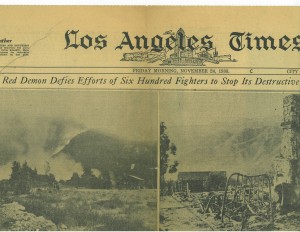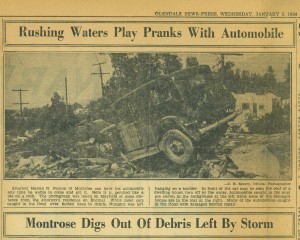 Part 1 and Part 2 of this series explain the geography of the Los Angeles basin, including the steep mountains rimming the northern edge of the basin that were pushed up by the action of two tectonic plates meeting along the San Andreas Fault. The articles discussed how the dense chaparral burns fast and hot pushed by the hot winds coming over the mountains from the desert causing the soil to become almost waterproof. All that it takes to set off a huge flood of mud is rain.
Part 1 and Part 2 of this series explain the geography of the Los Angeles basin, including the steep mountains rimming the northern edge of the basin that were pushed up by the action of two tectonic plates meeting along the San Andreas Fault. The articles discussed how the dense chaparral burns fast and hot pushed by the hot winds coming over the mountains from the desert causing the soil to become almost waterproof. All that it takes to set off a huge flood of mud is rain.
The Great Depression that started with the stock market crash in the fall of 1929 hit rock bottom in the spring of 1933. It would be a slow recovery that would not end until the advent of World War II. New Year’s Eve 1933 was still reason for many to celebrate the promise of the New Year. In the little Crescenta-Canada Valley many residents had gone out for the evening. It had been raining for a couple of days, so a warm gathering of friends must’ve sounded good. Unfortunately the loudest noises that evening would not be man-made.
Rusty’s dad had not moved to the valley yet in 1933, but as commander of the local American Legion Verdugo Hills post 288, he became friends with many of the “old-timersâ€. One of these friends gave him a box of old newspapers, including papers from the great flood of 1934 and a souvenir folder that had been published by the American Legion in January 1934. The proceeds from the sale of the folder would be used to build a new legion hall with a Boy Scout clubroom to replace what was destroyed when the American Legion Hall was swept away.
The preface to the souvenir folder reads in part:
“Last November a fire swept the southerly side of that towering watershed, completely denuding it as if the slopes had been planed with a giant rasp.  Preceded by two days of heavy rains, 1934 was but a few minutes old when a cloudburst loosened a deluge of water over these fire destroyed slopes and a wall of water from 10 to 15 feet high started on its path of destruction. Its swept on down the mountainside toward the beautiful towns of Montrose and La Crescenta . With a thundering roar it struck. It was maddening to see and deafening to hear. On its crest were the wreck of houses and in its foam dead bodies were tossed.
Preceded by two days of heavy rains, 1934 was but a few minutes old when a cloudburst loosened a deluge of water over these fire destroyed slopes and a wall of water from 10 to 15 feet high started on its path of destruction. Its swept on down the mountainside toward the beautiful towns of Montrose and La Crescenta . With a thundering roar it struck. It was maddening to see and deafening to hear. On its crest were the wreck of houses and in its foam dead bodies were tossed.
In Montrose, the American Legion Post 288, had thrown open its doors to refugees from the rain; some 16 people were there when the flood hit the building, tearing gasping holes in the back, and rushing through, carried its precious cargo of human lives with it. On it swept—down–ever claiming lives, homes, and property; destroying everything in its path.”
A light rain had started on December 30, 1933 but intensified quickly into what was then a record downpour of 7.31 inches in 24 hours. By midnight December 30, 1934 the mountains began to unleash terror on the valley below. When most people think of a flood they think of water. But in this area they refer to a “debris flow” because the water carries so much mud, dirt, and rock from those crumbling hillsides; picking up trees, bushes, houses, people, and anything in its way, getting more powerful as it goes.
The steep mountains cause this mud flow to move fast and high, somewhere between 15 and 20 feet by the time it hit the valley. The Red Cross headquarters at the American Legion was the place people started to gather; unfortunately right in the path of the mudflow. It was later rebuilt where it stands now, a couple blocks away. Its original location, noted by a historical marker, is right on top of what is now a flood control channel. 
The destruction was so horrific that it inspired Woody Guthrie to compose a song entitled “The Los Angeles New Year’s flood”. Rusty obtained a copy of the song from the Smithsonian. Woody gives an introduction noting that since this was during the Depression many poor families actually lived up above the foothill communities in the washes and canyons of the great San Gabriel Mountains. These folks lived off the land as there was fish and game readily available. Unfortunately, the official  death toll from the flood is probably much lower, says Mr. Guthrie, than the actual death toll, because they did not take into account the hundreds of folks living up in the hills who were simply washed away or buried.
Looking through the papers from early January 1934, Rusty notes that folks who would later be his friends and actually work for his father were listed as missing. This is apparently because they had gone to a party that night and could not get back to their home because of the floods. Some houses were moved over 400 feet by the debris flow, with their occupants inside! Hundreds of old model A’s were buried in downtown Montrose. In the end, over 200 homes were destroyed; 400 uninhabitable.
Part 4 of this series will discuss the efforts of the Los Angeles County Flood Control District and other agencies to prevent such a disaster from ever happening again. Another look at those old newspapers gives a clue. Meanwhile here is one of Rusty’s favorite clips from the 1934 papers.  The picture is of the Boy Scouts holding what is only identified as “the tusk of the giant prehistoric animal” (hence the “evidence of monsterâ€, likely either an American mastodon or Mammoth). It’s an interesting photo as they stand in front of a destroyed building next to a boulder that had washed out of the mountains. Many of the boulders were several times the size!


0 comments ↓
There are no comments yet...Kick things off by filling out the form below.
Leave a Comment